
Original Link: https://www.anandtech.com/show/1658
Patriot DDR400 2-2-2/DDR533 3-4-4: Performance AND Value
by Wesley Fink on April 8, 2005 12:05 AM EST- Posted in
- Memory
Since it was first introduced by Corsair almost a year ago, memory based on Samsung TCCD chips has become the performance standard for DDR memory. As we saw in our roundup of memory for the AMD Athlon 64, Samsung TCCD also performs particularly well on the Athlon 64 with the on-chip memory controller. Almost every memory manufacturer now has a version of its own TCCD memory. In our recent reviews, we have seen TCCD from Corsair, G. Skill, Geil, Mushkin, OCZ, and PQI. All of the TCCD-based memory performs well, with the best performance coming from TCCD based on the Brainpower PCB. While Samsung TCCD has recently been challenged by Crucial Ballistix and the revival of Winbond parts in OCZ VX and the new BH5 Value RAM, there is no doubt that in most systems, at the voltage ranges seen in most motherboards, TCCD-based memory is the standard.
Into this climate, PDP Systems has introduced its own Samsung TCCD memory built on the Brainpower PCB. Patriot has chosen to rate the PC3200+XBLK at two different speeds: DDR400 at 2-2-2-5 and DDR533 at 3-4-4-8. This is quite a broad range and we will see if the memory meets or exceeds those ratings. The Patriot memory also stands out from the TCCD crowd by being the most reasonably priced TCCD that we could find on the web. At around $225 for a 1GB (512MB x 2) pair, the Patriot is even cheaper than the lowest-priced G. Skill at the vendors where we checked. Since the largest barrier to TCCD pricing is the actual cost of the chips from Samsung, reportedly about $6 per chip (or $190 for 32 chips for a 1GB pair), then Patriot is very near the lowest price currently possible for TCCD modules.
The question, of course, is how the Patriot performs compared to other TCCD-based memory. It has the right stuff in its design, but does it deliver in the all-important performance arena?
Patriot PC3200+XBLK
PDP Systems (www.pdpsys.com) and the Patriot brand will be a new name for some readers. However, Patriot memory has been a line at Fry's/Outpost in the past and it is also available at New Egg and other web resellers. PDP Systems was founded in California's Silicon Valley in 1985. They have manufactured memory products for the past 14 years and they are also a member of Jedec, which is the memory industry standards organization. PDP currently markets a full line of DDR and DDR2 memory products, flash memory, and ATI video cards. On a global basis, PDP has two distribution centers in California, a Mid-West sales office, a Hong Kong sales/purchasing office and a Taiwanese purchasing affiliate.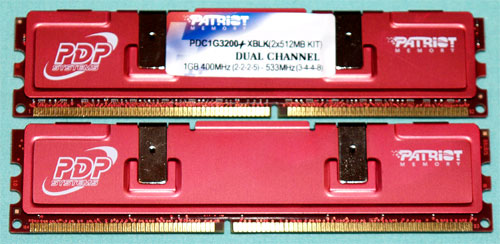
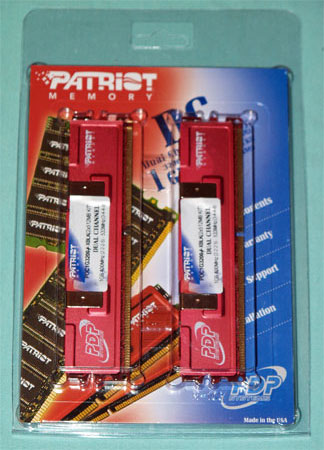
Patriot PC3200+XBLK Specifications
Recognizing the extremely wide performance range of TCCD memory, PDP rates the memory at both DDR400 2-2-2-5 and DDR533 3-4-4-8. According to Patriot, the memory is tested in production at both specifications to ensure consistent performance.| Patriot PC3200+XLBK (DDR400/533) Memory Specifications | |
| Number of DIMMs & Banks | 2 DS |
| DIMM Size Total Memory |
512 MB |
| Rated Timings | 2-2-2-5 at DDR400 3-4-4-8 at DDR533 |
| SPD (Auto) Timings | 2-3-2-5 |
| Rated Voltage | 2.6V |
The XBL designation apparently signifies "eXtended Bandwidth and Latency". In the case of Samsung TCCD on a Brainpower PCB, this is certainly an apt description.
With Intel's introduction last summer of the Intel 915/925X chipsets with support for DDR2 memory, the primary market for DDR memory has become the excellent AMD Athlon 64 platform. However, some 915 boards also support DDR, and the continuing Intel Socket 478 also supports DDR memory. For these reasons, Patriot PC3200+XBLK was only tested on the DFI LANParty nF4 SLI-DR Athlon 64 Socket 939 test bed. This is the test bed that we recently used in evaluating OCZ VX memory in OCZ VX Revisited: DDR Updates on DFI nForce4.
Performance Test Configuration
Patriot PC3200+XBLK was tested on the DFI LANParty nF4 SLI-DR. nForce4 is PCI Express, so we used the PCIe version of our standard nVidia 6800 Ultra for testing. Other components remain the same as used in the memory setup in Athlon 64 Memory: Rewriting the Rules . Performance was compared to the 4 memories retested on this platform in OCZ VX Revisited: DDR Updates on DFI nForce4.The A64 test bed includes components that have been proven in Socket 939 Athlon 64 benchmarking, such as the Socket 939 4000+ (same specifications as FX53), and the OCZ Power Stream 520 Power Supply. Since the Athlon 64 tests represent a new series of DDR testing, we have chosen the current generation nVidia 6800 Ultra video card for benchmarking. We have found the 6800 Ultra to be a particularly good performance match to nVidia motherboards.
All other basic test conditions attempted to mirror those used in our earlier Intel memory reviews. However, test results are not directly comparable to tests performed on the Intel test bed.
| AMD nForce4 Performance Test Configuration | |
| Processor(s): | AMD 4000+ (FX53) Athlon 64 (2.4GHz, Socket 939, 1 MB cache, Dual Channel, 1000HT) |
| RAM: | Patriot PC3200+XBLK (DS) 2X512MB OCZ EL PC4000 VX Gold (DS) 2X512MB Corsair TwinX1024-4400C25 (DS) 2X512MB Crucial Ballistix (DS) 2X512MB OCZ PC3200 Platinum Rev 2 (DS) 2X512MB |
| Hard Drives: | Seagate 120GB SATA 7200RPM 8MB Cache |
| PCI/AGP Speed: | Fixed at 33/66 |
| Bus Master Drivers: | nVidia nForce Platform Driver 6.39 |
| Video Card(s): | nVidia 6800 Ultra 256MB PCIe, 256MB aperture, 1024x768x32 |
| Video Drivers: | nVidia Forceware 71.84 Release |
| Power Supply: | OCZ Power Stream 520W |
| Operating System(s): | Windows XP Professional SP1 |
| Motherboards: | DFI LANParty nF4 SLI-DR |
In past benchmarking, we have found performance of the nForce4 and nForce3 chipsets to be virtually identical, and we have found AGP and PCIe performance to be virtually the same in the benchmarks that we use for memory testing. Therefore, you can also compare results to TCCD results in a recent memory review. The differences will be that the nVidia 71.84 driver is a bit faster than the 61.77 used in earlier memory review. The DFI nForce4 platform is also a bit better at memory overclocking than the MSI K8N Neo2 used in past memory testing.
With nForce3 motherboards, we achieved the fastest performance on AMD Athlon 64 chipsets (nForce3, VIA K8T800 PRO) at Cycle Time or tRAS of 10. However, as we saw in the recent nForce4 SLI roundup, the nForce4 appears to behave a bit differently with memory. Therefore, we ran a complete set of Memtest86 benchmarks with only tRAS varied to determine the best tRAS setting for Patriot PC3200. All memories showed their best bandwidth at a tRAS setting of 6, so a tRAS setting of 6 was used for testing wherever possible.
Test Settings
All AMD Athlon 64 processors are unlocked downward, and the FX CPUs are unlocked up and down. This feature allows a different approach to memory testing, which truly measures performance differences in memory speed alone. All tests were run with CPU speed as close to the specified 2.4GHz of the 4000+/FX53 as possible, with CPU speed/Memory Speed increased at lower multipliers to achieve 2.4Ghz. This approach allows the true measurement of the impact of higher memory speed and timings on performance, since CPU speed is fixed, thus removing CPU speed as a factor in memory performance.The following settings were tested with the Patriot PC3200+XBLK on the DFI nF4 test bed:
- 2.4GHz-12x200/DDR400 - the highest stock memory speed supported on K8T800-Pro/nF3-4/SiS755-FX motherboards.
- 2.4GHz-11x218/DDR436 - a ratio near the standard DDR433 speed
- 2.4GHz-10x240/DDR480 - a ratio near the standard rating of DDR466
- 2.4GHz-9x267/DDR533 - a standard memory speed used in testing other high-speed memory
- 2.4GHz-8x300/DDR600 - tested where this speed could be achieved
- Highest Memory Performance - the highest memory bandwidth and game performance that we could achieve with the memory being tested; this is rarely the highest memory speed that we could achieve - It is normally a lower speed with 1T Command Rate and tighter memory timings.
We ran our standard suite of memory performance benchmarks - Quake 3, Return to Castle Wolfenstein-Enemy Territory-Radar, Super Pi 2M, and Sandra 2004 Standard and UnBuffered. We also included Everest Home Edition memory tests, free at www.lavalys.com, for read speed, write speed, and Latency.
Test Results : Patriot PC3200+XBLK
To be considered stable for test purposes, Quake3 benchmark, UT2003 Demo, Super PI, Aquamark 3, and Comanche 4 had to complete without incident. Any of these, and particularly Super PI, will crash a less-than stable memory configuration.| Patriot PC3200+XBLK (DDR400/533) - 2 x 512Mb Double-Bank | |||||||
| CPU Ratio at 2.4GHz | Memory Speed |
Memory Timings & Voltage |
Quake3 fps |
Sandra UNBuffered | Sandra Standard Buffered |
Super PI 2M places (time in sec) |
Wolfenstein - Radar - Enemy Territory fps |
| 12x200 | 400 DDR | 2-2-2-6 2.6V 1T |
545.5 | INT 2773 FLT 2952 |
INT 6091 FLT 6033 |
80 | 114.5 |
| 11x218 | 436 DDR | 2-3-2-6 2.8V 1T |
542.3 | INT 2791 FLT 3002 |
INT 6455 FLT 6388 |
81 | 114.0 |
| 10x240 | 480 DDR | 2.5-3-3-6 2.8V 1T |
547.8 | INT 2920 FLT 3135 |
INT 6700 FLT 6627 |
81 | 114.6 |
| 9x267 | 533 DDR | 2.5-3-3-6 2.9V 1T |
556.1 | INT 3188 FLT 3379 |
INT 7032 FLT 6948 |
80 | 116.0 |
| 8x300 | 600 DDR | 2.5-4-3-6 2.9V 1T |
561.5 | INT 3298 FLT 3567 |
INT 7199 FLT 7111 |
79 | 117.1 |
| 9x315 (2.83GHz) |
Highest CPU/Mem Performance 630 DDR |
2.5-4-3-7 2.9V 1T |
642.0 | INT 3642 FLT 3905 |
INT 7820 FLT 7946 |
72 | 135.2 |
In rows 1 to 5, CPU speed is kept at 2.4GHZ and only the Memory Speed is varied. The performance differences you see in that range are a result of Memory Speed and memory timings only.
We have looked at Aida 32 results in the past, and found them very useful in examining read/write performance and memory latency. Aida 32 is now available as Everest Home Edition, a free download from www.lavalys.com.
| Everest 1.51 Patriot PC3200+XLBK (DDR400/533) 2x512Mb Double-Bank |
|||||
| CPU Ratio at 2.4GHz | Memory Speed | Memory Timings & Voltage |
Everest READ MB/s |
Everest WRITE MB/s |
Everest Latency ns |
| 12x200 | 400 DDR | 2-2-2-6 2.6V 1T |
5877 | 2033 | 45.8 |
| 11x218 | 436 DDR | 2-3-2-6 2.8V 1T |
6170 | 2056 | 44.6 |
| 10x240 | 480 DDR | 2.5-3-3-6 2.8V 1T |
6666 | 2207 | 44.2 |
| 9x267 | 533 DDR | 2.5-3-3-6 2.9V 1T |
7209 | 2325 | 40.7 |
| 8x300 | 600 DDR | 2.5-4-3-6 2.9V 1T |
7561 | 2379 | 40.4 |
| 9x315 (2.83GHz) |
Highest CPU/Mem Performance 630 DDR |
2.5-4-3-7 2.9V 1T |
8310 | 3321 | 35.2 |
While maintaining a constant CPU Speed of 2.4GHz, we measured the impact of increasing the Memory Speed from 200 to 300, a 50% increase. Memory Read performance increased about 29% with this 50% speed increase, while Memory Write performance improved by just 17%. Latency showed a reduction or speedup of about 12%. With any TCCD memory, Memory Read/Write/Latency benchmarks are also impacted by the slower memory timings required at higher speeds.
Performance Comparisons
Performance of the Patriot PC3200+XBLK was compared to all of the memory recently tested on the DFI nF4 AMD Athlon 64 platform. Performances of the nForce4 and nForce3 chipsets were found to be virtually identical in past reviews. We also found AGP and PCIe performance to be virtually the same in the benchmarks that we use for memory testing. Therefore, you can also compare results to other TCCD results in a recent memory review. The differences will be that the nVidia 71.84 driver is a bit faster than the 61.77 used in earlier memory review. In memory overclocking, the DFI nForce4 platform also enables a bit better memory speeds than the MSI K8N Neo2 used in past memory testing.While we did not test on an Intel platform, the performance results can also be generally compared to previous DDR benchmark results on the Intel 875 memory test bed. More results are available in recent DDR memory reviews at:
OCZ VX Revisited: DDR Updates on DFI nForce4
OCZ VX Memory + DFI nForce4 = DDR533 at 2-2-2
Corsair 4400C25: Taking Samsung TCCD to New Heights
PQI & G. Skill: New Choices in 2-2-2 Memory
Athlon 64 Memory: Rewriting the Rules
OCZ 3700 Gold Rev. 3: DDR500 Value for Athlon 64 & Intel 478
Geil PC3200 Ultra X: High Speed & Record Bandwidth
= F-A-S-T= DDR Memory: 2-2-2 Roars on the Scene
Buffalo FireStix: Red Hot Name for a New High-End Memory
New DDR Highs: Shikatronics, OCZ, and the Fastest Memory Yet
The Return of 2-2-2: Corsair 3200XL & Samsung PC4000
OCZ 3700EB: Making Hay with Athlon 64
OCZ 3500EB: The Importance of Balanced Memory Timings
Mushkin PC3200 2-2-2 Special: Last of a Legend
PMI DDR533: A New Name in High-Performance Memory
Samsung PC3700: DDR466 Memory for the Masses
Kingmax Hardcore Memory: Tiny BGA Reaches For Top Speed
New Memory Highs: Corsair and OCZ Introduce DDR550
OCZ PC3700 Gold Rev. 2: The Universal Soldier
OCZ 4200EL: Tops in Memory Performance
Mushkin PC4000 High Performance: DDR500 PLUS
Corsair TwinX1024-4000 PRO: Improving DDR500 Performance
Mushkin & Adata: 2 for the Fast-Timings Lane
Searching for the Memory Holy Grail - Part 2
DDR400/2.4GHz Performance
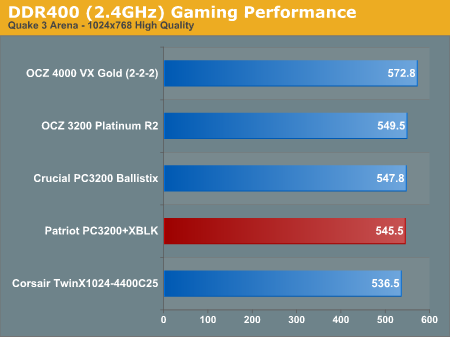
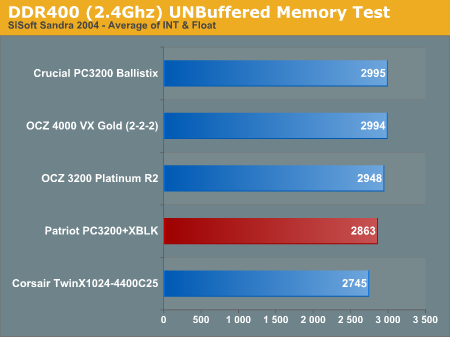
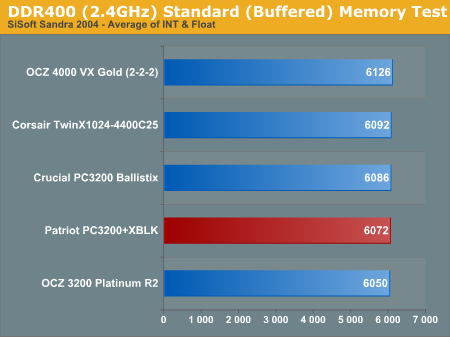
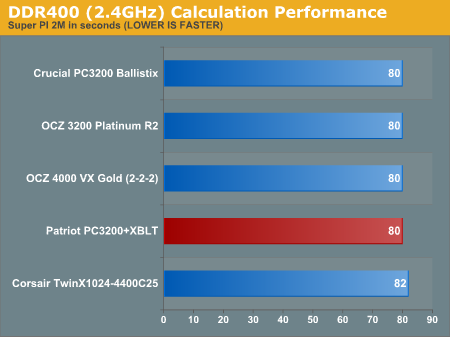
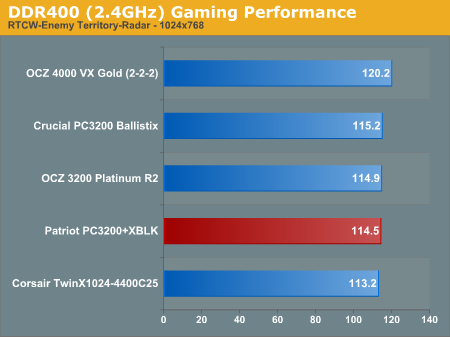
DDR436/2.4GHz Performance
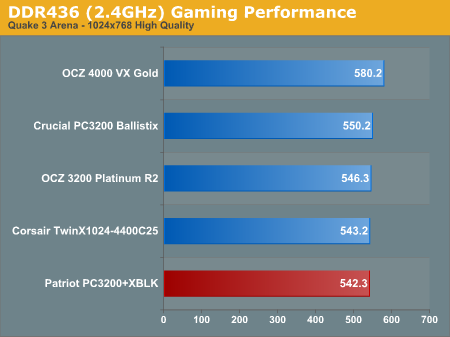

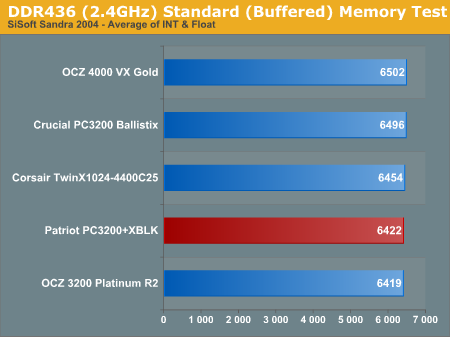
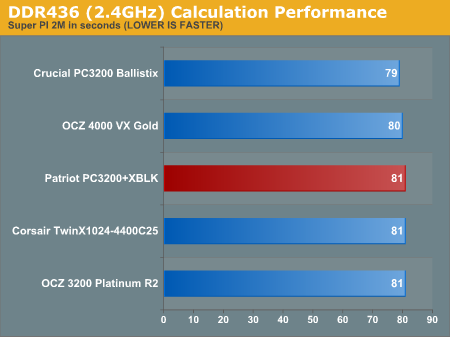
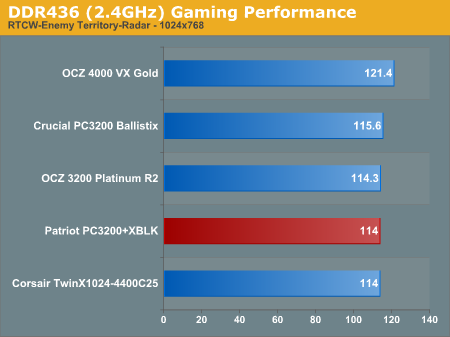
DDR480/2.4GHz Performance


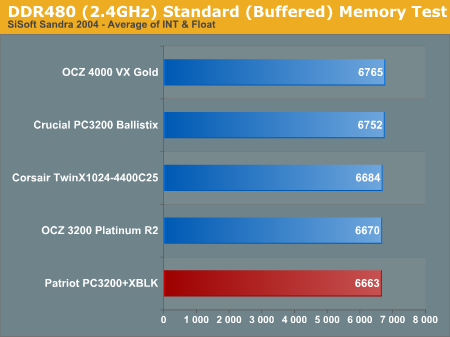
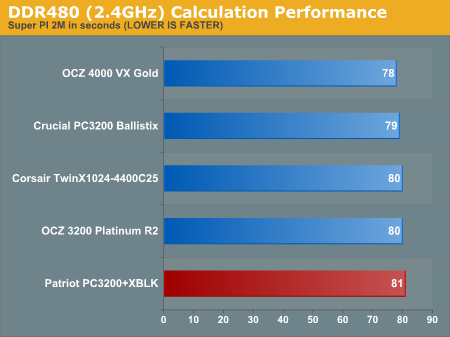
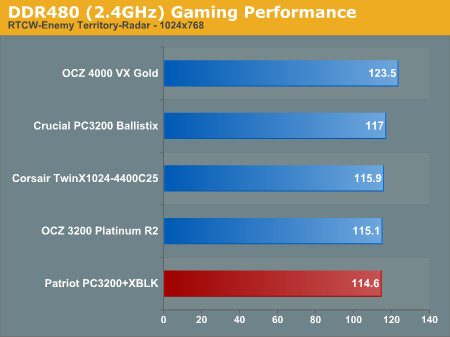
DDR533/2.4GHz Performance
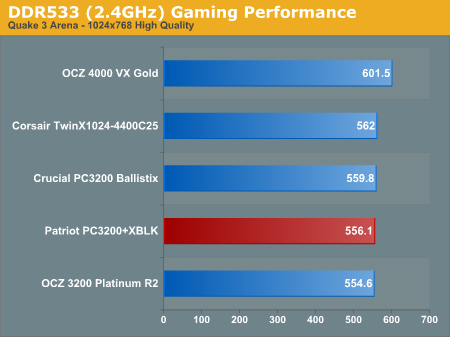
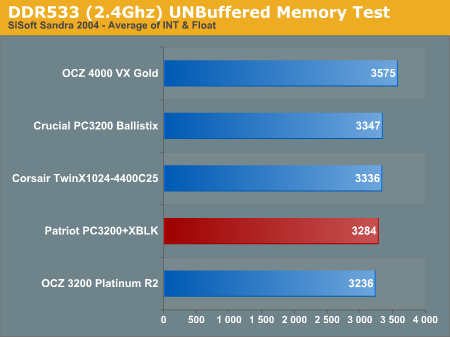
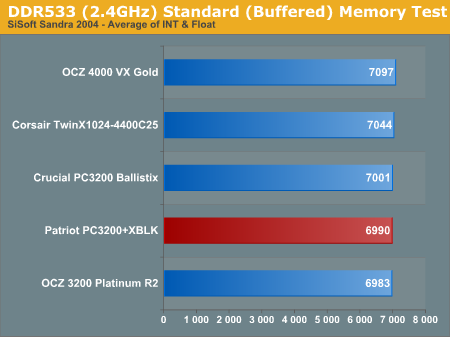
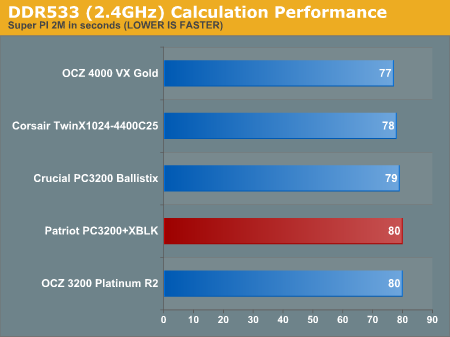
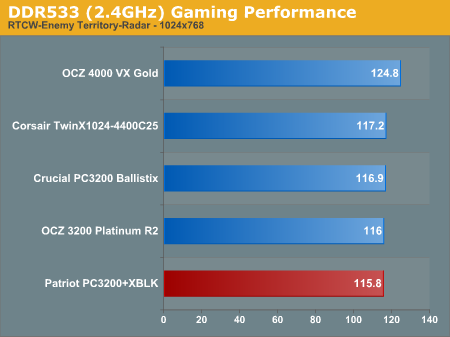
Highest Performance
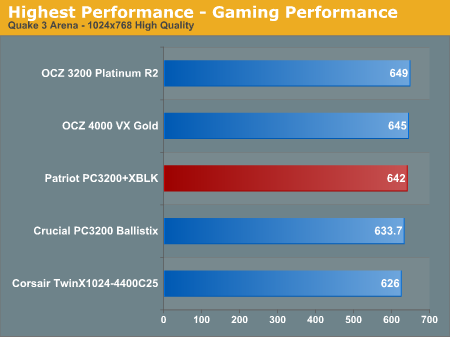
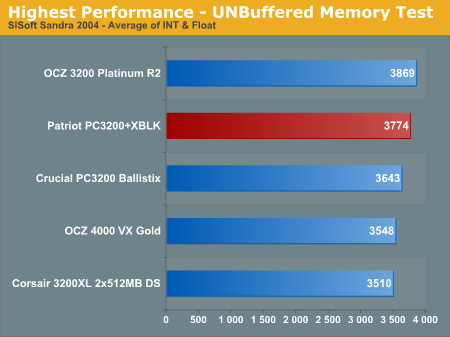
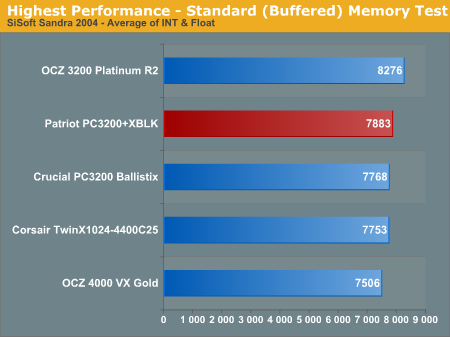
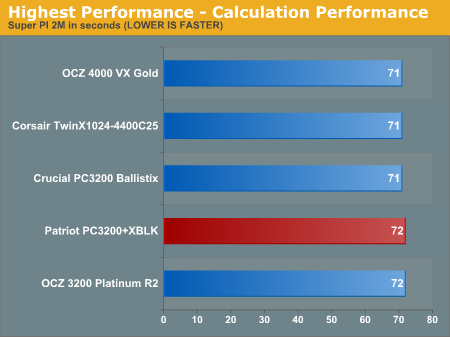
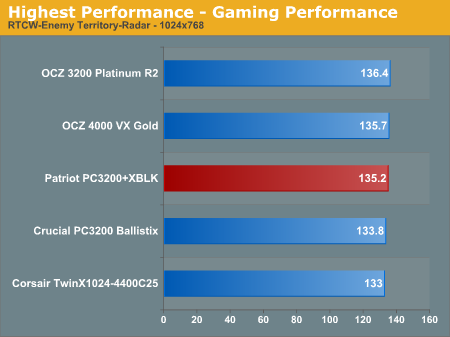
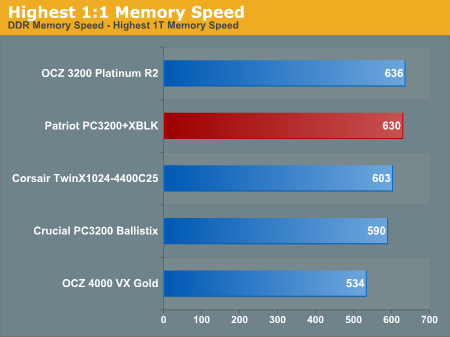
Final Words
While Patriot may be a new name in the Enthusiast memory market, PDP Systems has produced a solid memory product based on Samsung TCCD memory chips that performs as well as any top TCCD that we have tested. Significantly, Patriot TCCD is also the most reasonable quality TCCD memory on the market today. All of this adds up to Top Performance and Top Value, which is high praise for this Patriot memory.As a buyer, you get a memory that is tested at both DDR400 2-2-2-5 and DDR533 3-4-4-8 during production. Our test modules actually performed much better than these base settings, reaching a stable DDR630 at 2.5-4-3-7 timings at 2.9V on the AMD Athlon 64 platform. This performance was virtually identical to the outstanding OCZ PC3200 Platinum Rev. 2 that is our reference memory and one of the top memories available for the AMD platform.
PDP Systems used top components in their Patriot PC3200+XBLK, starting with a Brainpower PCB, and continuing with what appears to be effective binning of production TCCD chips. You will either love or hate the flame-red aluminum heatspreaders and the red PCB, but no one will ever accuse Patriot of not standing out in the crowd. All-in-all, Patriot PC3200+XBLK is an outstanding performer at a very good price. Other memory makers tell me that they have also recently reduced prices on TCCD memory. So, if you're shopping for the great extended performance range of TCCD-based memory, you should check the latest prices before buying. Just make sure that the TCCD you choose is based on the Brainpower PCB and is actually tested during production at higher memory speeds.
We are happy to recommend Patriot PC3200+XBLK to anyone looking for TCCD-based memory or a top memory for their AMD Athlon 64 system. The Patriot provides solid performance to DDR630 in our benchmarks at the voltages available on most performance motherboards. It is not as fast as OCZ VX at the same memory speed, but it can reach similar performance levels at top speed by performing at higher speeds than VX. If your board cannot do the very high voltages required by VX, or if you prefer to run lower voltages for safety, then Patriot PC3200+XBLK is an excellent memory choice.







